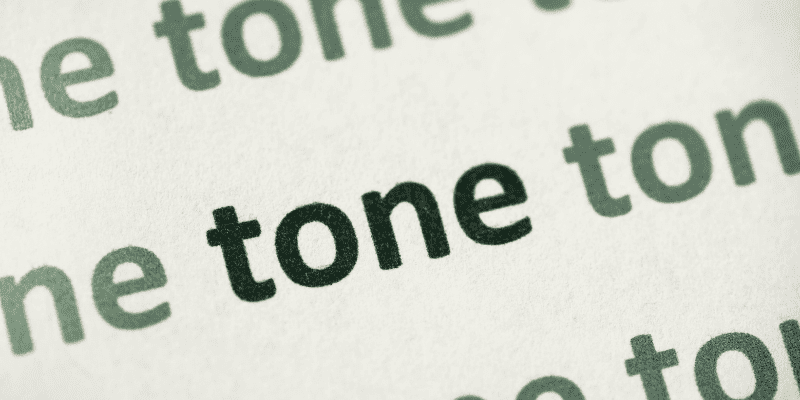Your tone of voice can be one of the most important tools in your writing toolbox. It can help to set the tone for your entire piece, and it can help to engage your readers from the very beginning. In order to find the right tone for writing, you’ll need to consider your audience, your purpose, and your tone of words.
By taking these into account, you can create a voice that resonates with readers. In this post, we’ll explore common types of tones that will keep the reader interested in your content!
What is a writing tone?
The tone in writing is the feeling or mood a piece of written communication conveys. It can be formal or informal, positive or negative, serious or playful.
The tone of a piece is often determined by its sentence structure, level of formality, and use of adjectives. To create the perfect tone for a piece of writing, the author may consider what tone best suits the subject and audience.
The tone should be different for a job application cover letter and an email to a friend!
Shorter sentences create a more abrupt, staccato tone, while longer sentences convey a more mellow, relaxing one. The syntax, or sentence structure, of a piece of writing, can contribute to its overall tone.
The words used in a piece of writing play a role in its overall tone. Specific word choices can convey different shades of meaning, which can affect the tone of the writing.
For instance, using the word “furious” rather than “angry” conveys a stronger feeling of rage. The tone of a piece of writing is determined by its overall purpose and audience.

Why the tone of writing is important
Writing tone can have a big impact on how readers perceive a piece of content and its effectiveness.
Whatever the topic or purpose of a piece of writing is, it is important to choose an appropriate tone to engage the reader and convey the desired message.
- A friendly, conversational tone can make readers sense they are talking with the author. A formal tone can make them feel as though they are being lectured.
- The tone can affect how persuasive the writing is. A confident tone is more likely to convince readers than a hesitant or negative one.
- A lighthearted tone can make a difficult subject palatable, while a serious tone can convey the gravity of a situation. If you’re writing an informative article, a playful tone is not appropriate.
In short, the tone of a piece of writing matters in determining how readers will react to it.
16 Different types of tones in writing
The tone of a piece of writing can set the mood, create an atmosphere, and convey the author’s attitude. It’s important to choose the right tone for the desired effect. Here are 16 types of writing tones that authors can use:
1. Humorous: A humorous tone is light-hearted and used to make readers laugh. They use this tone in comedies and satire.
2. Serious: They use a serious tone in academic or professional writing to convey a sense of importance.
3. Sensitive: A sensitive tone is compassionate and may be used for controversial or emotional topics. This tone can create empathy in the reader.
4. Inspirational: An uplifting and motivational tone that seeks to encourage others.
5. Intimate: An intimate tone is personal and often used in confessional writing or when discussing private matters. This type of tone creates a sense of closeness between the author and the reader.
6. Collaborative: A cooperative and amicable tone that encourages communication and teamwork.
7. Formal: A formal tone is objective and often used in business or government writing. This tone keeps things professional and exercises restraint in emotions.
8. Informal: An informal tone is relaxed and used when conversing with friends or family members. This tone creates a connection between the author and the reader.

9. Persuasive: A convincing and persuasive tone that tries to win support for an idea or cause.
10. Conciliatory: A peace-seeking tone that aims to soothe or placate.
11. Objective: They use an objective tone when reporting facts. This tone removes any bias from the writing so that readers can form their own opinions about the information presented.
12. Explanatory: A clarity-seeking tone that provides information and understanding.
13. Aggressive: They use a confrontational tone when making powerful arguments or criticisms. It can be useful for getting the reader’s attention. We should use it sparingly to avoid alienating people.
14. Passive: A passive voice is indirect and often uses phrases such as “I think” or “It seems.” This sentence construction can make writing wishy-washy, but it can make difficult topics more palatable for readers.
15. Decisive: A determined and forceful tone that communicates the strength of purpose.
16. Diplomatic: A diplomatic voice takes care not to offend anyone. Neutral language is used. This tone can be useful in business or political contexts when maintaining relationships is key.
How to develop your tone for writing
One of the most important aspects of writing is developing the right tone. The tone of your writing should match the purpose and audience of your piece so you can reach them.. Are you trying to communicate with experts in your field, or are you aiming for a more general audience?
One way to develop your tone is to read examples of writing that match the tone you’re trying to achieve.
If you’re aiming for a casual tone, look for blog posts or articles written in a similar style. If you’re aiming for a more formal tone, look for examples of well-written essays or news articles.
Writing in the style you’re going for is one way to develop your tone. The more you write, the more natural it will become. With practice, you’ll be able to develop the perfect tone for any piece of writing.
The tone of your work should be in line with its intended use. Keep in mind the overall tone of your website or publication. If you’re writing for a site that uses a formal tone, it’s not the best place to experiment with slang or irreverence.
A site known for its humor may not be the best place to publish a serious opinion piece. By considering these factors, you can develop a writing tone that is both effective and appropriate for your audience.
To create the perfect tone for your writing, you can mix and match unique pieces of writing you think work well together. You can use online resources, books, or even your own experiences to help you create the perfect tone for your piece of writing.
Ask for feedback from family and friends – they can often give you a helpful perspective on how your writing sounds. With practice, you’ll soon develop a distinct writing voice that will help you engage your readers!
The formal tone in writing
A formal tone in writing uses proper grammar and no contractions. The more formal the topic, the more formal the language. This formality is common in business writing as it sounds more professional.
They can use formality in other fields, such as academic writing. To create a more serious or authoritative tone, they keep the sentence construction simple. This formality can make formal writing sound stilted or staid, but it ensures that the reader takes the writing seriously.
The formality of a piece of writing is often determined by its purpose. When in doubt, use formality. It is easy to make something sound more casual, but difficult to make something sound formal after it has been written.

A conversational tone
In writing, a conversational tone is one that resembles a natural speech pattern. This means using contractions, such as “I’m” instead of “I am,” and using common slang or colloquialisms.
They often use it in articles, emails, and other documents where a more formal tone is out of place.
The goal is to sound like a casual conversation between friends and less like a formal essay. A conversational tone can be effective but is not proper for all audiences.
For example, you would not use a conversational tone in a cover letter or a resume. Though, using a conversational tone can help to make your writing more relatable.
When using a conversational tone, avoid sounding too stiff or formal. Focus on creating a relaxed and friendly mood. Use short, simple sentences and contractions when appropriate.
In addition, try to use language that your audience will understand. By following these tips, you can make sure that your writing has a conversational tone that is both engaging and accessible.
How to create the perfect tone for writing
One of the most important elements of writing is creating the perfect tone. The tone of a piece can set the mood and atmosphere, and it can influence how readers interpret the events taking place.
For example, a light-hearted and humorous tone will create a different effect than a dark and suspenseful one.
There are several things to consider when creating the perfect tone for a piece of writing. First, think about the overall mood that you want to convey. Do you want your readers to feel happy, scared, or sad?
Picking the right words
Once you know the mood, you can choose your words. Use descriptive language to paint a picture in your readers’ minds, and be sure to use adjectives that convey the desired effect. Pay attention to sentence structure and word choice – shorter sentences can create a more tense feeling, while longer ones are more relaxed.
With writing, for example, a light-hearted and humorous tone will create a different effect than a dark and suspenseful one. The purpose and tone of the writing should be appropriate.
A formal business letter will have a different tone than an email to a friend. In order to create the perfect tone, it is important to understand the distinct elements that make up the tone, including voice, diction, and syntax.

The tone of voice is an important part of writing, whether for the web or more formal communications. By understanding the unique tones you can use in your writing, and by using them, you can create a tone that’s right for your audience and helps to convey your message.
